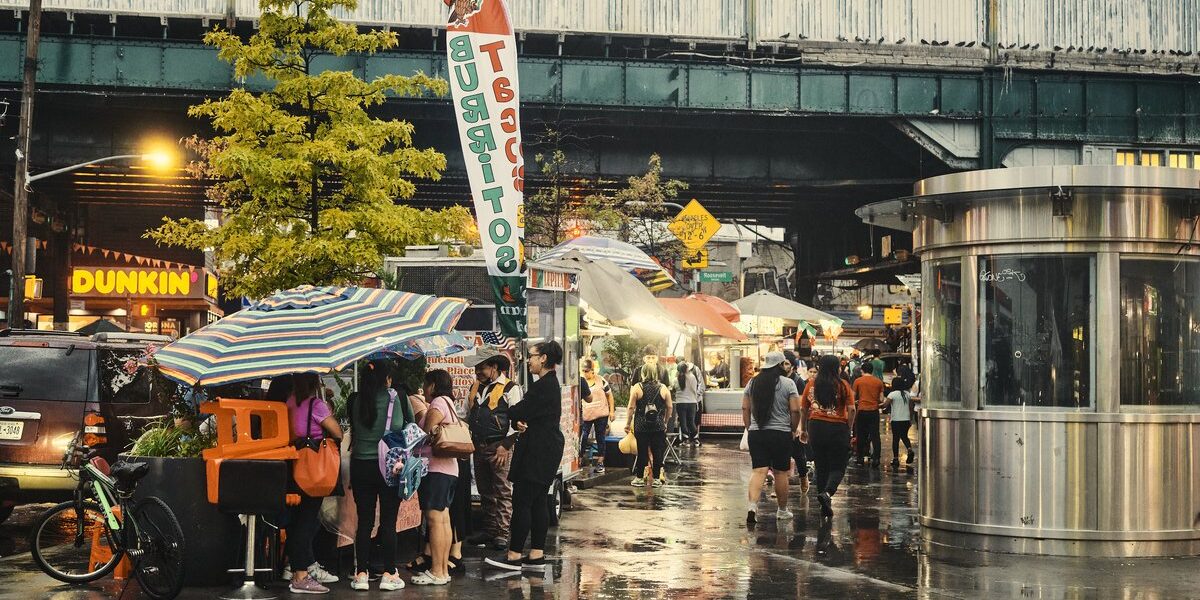A lot is unknown about the street vendors of New York City, the food sellers and goods merchants alike. Although many vendors conduct their business openly, they strive to fly under the radar of a vast bureaucracy arrayed to upset their fruit carts, uproot them from sidewalks and otherwise reduce their numbers.
A new study helps close the knowledge gap around these merchants, painting a detailed profile of an industry that will seem both familiar and unfamiliar to anyone who has ever purchased a street-vended fruit cup or considered the provenance of a sidewalk-sold designer watch.
The profile emerges in the “Street Vendors of New York,” a report by the Immigration Research Initiative. The report is based on surveys of more than 2,000 vendors and data analyzed by IRI and George Mason University statistics professor Jonathan Auerbach, and provides the first detailed analysis of the estimated 23,000 vendors earning a living in the trade across the five boroughs.
It offers insights into where the vendors are from (96% are immigrants), racial breakdowns (the vast majority are non-white), gender breakdowns (women are big players, but make up just a small fraction of those with licenses or permits), a glimpse into earnings (food vendors with a permit on average earn more than those without), and much more.
“Despite being a quintessential component of New York City streetscapes and daily life, before this report, little was known about the details about who street vendors are,” said Shamier Settle, senior policy analyst at IRI. “Now, we can show … what native New Yorkers, tourists, commuters and vendors already know to be true, while shedding light on other aspects of what it’s like to be a street vendor in New York.”
The study comes as the city undergoes another spasm of enforcement, with Mayor Eric Adams following the lead of his predecessors. The current effort has been highlighted by the NYPD’s confiscation of food carts, banning vendors from bridges, and viral videos of enforcement officers tangling with vendors.
At the same time, efforts to increase opportunities for lawful vending have failed to gain traction.
Some key findings from the report:
- 23,000 street vendors and counting. Auerbach estimates that’s how many are employed in the city’s street vendor economy, including business owners and workers. The overwhelming majority are food vendors (20,500), with an additional 2,400 being general merchandise vendors.
- Why we don’t know more about them. “This is because while local law requires street vendors to obtain licenses and permits to operate legally, the number of licenses and permits are limited, resulting in a largely unknown population of vendors that operate without a license or permit,” Auerbach writes in a separate paper.
- Where the immigrants are. Nearly all street vendors who are not military veterans (for whom separate rules apply), 96%, were born in another country. But the breakdown differs depending upon what’s being sold. Among immigrants who are mobile food vendors, 39% are naturalized citizens or permanent residents, 27% are undocumented, and 30% decline to answer. Among general merchandise vendors who are immigrants, about two-thirds are citizens or permanent residents, 13% are undocumented and 19% decline to answer.
- Streets vendors from across the world. The top five countries of origin for all street vendors are Mexico (30%), Ecuador (24%), Egypt (20%), Senegal (7%) and the United States (4%).
- Street vendors are predominantly people of color. Hispanics and Latinos make up 60% of street vendors; Middle Eastern or North Africans, 22%; East/South East Asian, 7%; Black or African American, 5%; white, 2%; and Native American, 1%. “This leaves many implications for enforcement and how that will disproportionately impact Black and brown immigrants,” according to the report.
- Another racial divide. Most merchandise vendors are Black or African American (62%), while most food vendors are Latino (62%).
- Where the required licenses and permits are. Licenses are required for general merchandise vendors, and most of those vendors (63%) have them. Permits are required for mobile food vendors, but most of those vendors (75%) lack them.
- Barriers to vending. The number of general vendor licenses issued to non-veterans is capped by law at 853. As of October 2023, the waiting list for general vendor licenses contained 10,992 names, and it’s been closed since 2016.
- Gender differences. Women make up half of food vendors and two-thirds of merchandise vendors, but women entrepreneurs are most likely to lack permitting or licenses.
- Earnings by whom and when. Mobile food vendors are most likely to have profits between $250 and $1,000 a week in both summer and winter, with more earning under $250 a week in winter. General merchandise vendors see a significant decline in winter. The majority earn $500 to $1,000 a week in summer, but most under $500 a week during winter.





